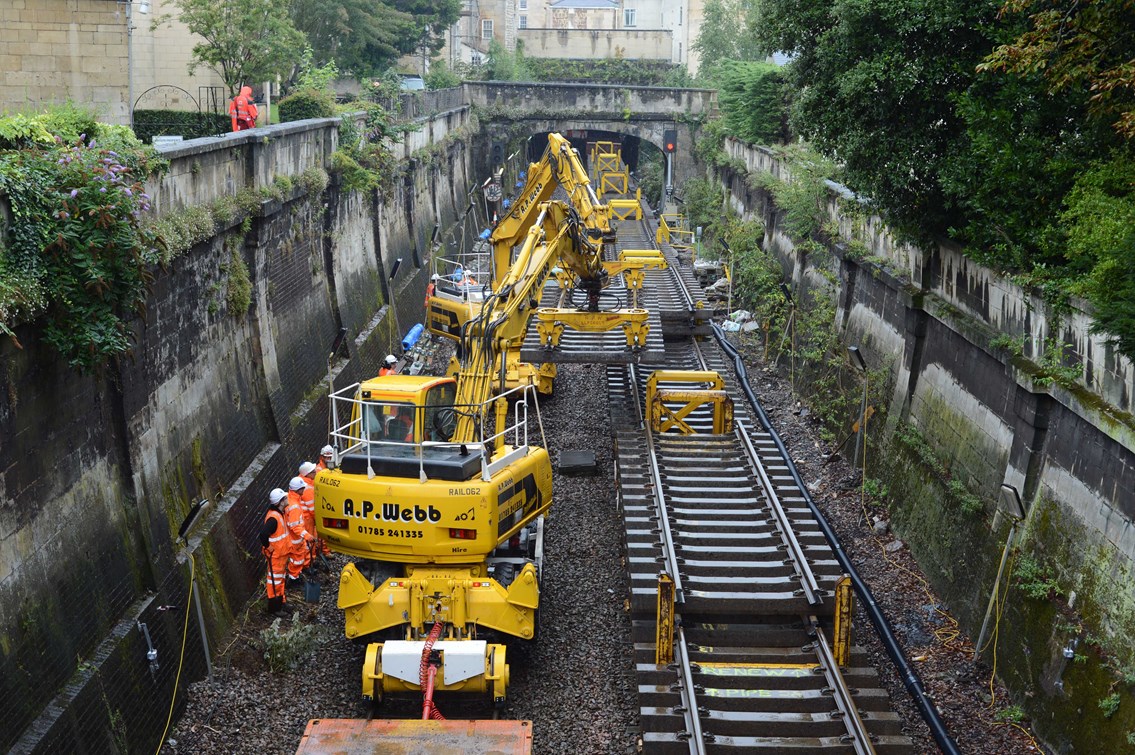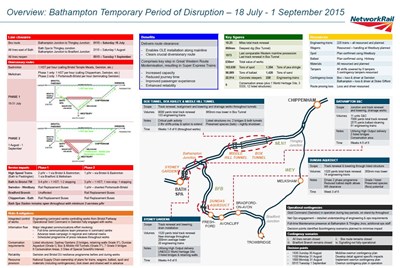Monday 7 Sep 2015
In numbers: Record-breaking track project successfully completed at Bath
- Region & Route:
- National
- | Wales & Western: Western
- | Wales & Western
The six-week project to lower and replace track in Bath and the surrounding area ready for electrification of the Great Western main line has been confirmed as the single biggest track renewals project ever undertaken by Network Rail.
During a mammoth programme which culminated over the August bank holiday weekend, Network Rail’s ‘orange army’ lowered and replaced 10km of track in Bath and its surrounding area in preparation for the arrival of a new fleet of faster, quieter and greener electric trains. As part of the £50m project, the team also installed 11 new switches and crossings, enabling trains to move from one track to another. The new lower track has created the additional headroom needed for the overhead lines that will power the new fleet of electric trains to run underneath, while simultaneously preserving Bath’s historic architecture.
Spread over five separate sites, the preparation work in Bath was the largest track project Network Rail has carried out to date and the biggest on the Western route for 40 years, culminating in the line re-opening to passengers, on time, on September 1
This stunning time-lapse footage shows the scale of the project and the level of work involved across the various sites, including the iconic Box Tunnel and the picturesque Sydney Gardens.
Separate time-lapse footage is also available for the key sites including Box Tunnel, Bathampton Junction, Sydney Gardens and Dundas Aqueduct.
Andy Haynes, Network Rail’s project director for the west of England, said: “We always knew this was going to be a complex project given the historic architecture and infrastructure we were working around, but I’m pleased to say all work was completed on time.
“Now this preparation work has been carried out, we will be able to install the overhead line equipment that will be used to power the new electric trains. These trains will provide passengers with more seats and faster journeys, while significantly reducing noise and pollution for those who live close to the railway line.”
Key facts and figures:
- Biggest track renewals possession ever. Over twice the size of the 37-day blockade at Nottingham in 2013 which had 107 engineering trains (the previous record holder)
- £50m budget
- 45-day temporary period of disruption
- 160,000 hours worked
- 10.25 km of track lowered and renewed
- 11 sets of switches and crossings lowered and renewed
- 2,539 people inducted to enter the possession
- No reportable injuries
- 500 welds completed
- 23,000 new concrete sleepers installed
- 98,000 tonnes of new ballast laid
- 217 logistics trains used (not including tamper shifts)
- 350 structural monitoring devices used to monitor the tunnels, bridges and walls during the works
- Two miles of high output ballast cleaning completed
- Typical dig depth was 650mm, with 300mm of new ballast below sleeper bottom to give a typical track lower of 350mm
- Track quality was such that the whole possession was reopened at 60mph rather than the planned 50mph
- Possession handed back 10 hours early (19:40 on 31 August)
- Just 26 calls received to Network Rail’s public helpline during the six weeks (roughly half were complaints about locomotive noise, either from the engines or the horns which have to be sounded before each train or Road Rail Vehicle (RRV) moves for track worker safety)
- Collaborative teamwork between Network Rail (Western Route, IP Western, IP Track, IP Signalling and National Supply Chain), Babcock and the S&C South Alliance
About the Great Western Electrification Programme
Electrification will transform the railway between London and Oxford, Newbury, Bristol and Cardiff to deliver a faster, greener, quieter and more reliable railway for passengers, with extra capacity. Electrifying this part of the Great Western route will enhance 235 miles of one of Britain’s busiest and oldest railways, better connecting major towns and cities across southern England and South Wales. This investment, as well as the introduction of a fleet of new trains, will improve journey times and make services more comfortable, smoother, cleaner and quieter for passengers and people living near the railway.
For more information about the Great Western Electrification Programme, visit http://www.networkrail.co.uk/great-western-route-modernisation/
Contact information
Passengers / community members
Network Rail national helpline
03457 11 41 41
Latest travel advice
Please visit National Rail Enquiries
Journalists
Network Rail press office -Dan Donovan
Media Relations Manager
020 3356 8700
Dan.Donovan@networkrail.co.uk
About Network Rail
We own, operate and develop Britain's railway infrastructure; that's 20,000 miles of track, 30,000 bridges, tunnels and viaducts and the thousands of signals, level crossings and stations. We run 20 of the UK's largest stations while all the others, over 2,500, are run by the country's train operating companies.
Usually, there are almost five million journeys made in the UK and over 600 freight trains run on the network. People depend on Britain's railway for their daily commute, to visit friends and loved ones and to get them home safe every day. Our role is to deliver a safe and reliable railway, so we carefully manage and deliver thousands of projects every year that form part of the multi-billion pound Railway Upgrade Plan, to grow and expand the nation's railway network to respond to the tremendous growth and demand the railway has experienced - a doubling of passenger journeys over the past 20 years.
Follow us on Twitter: @networkrail
Visit our online newsroom: www.networkrailmediacentre.co.uk


